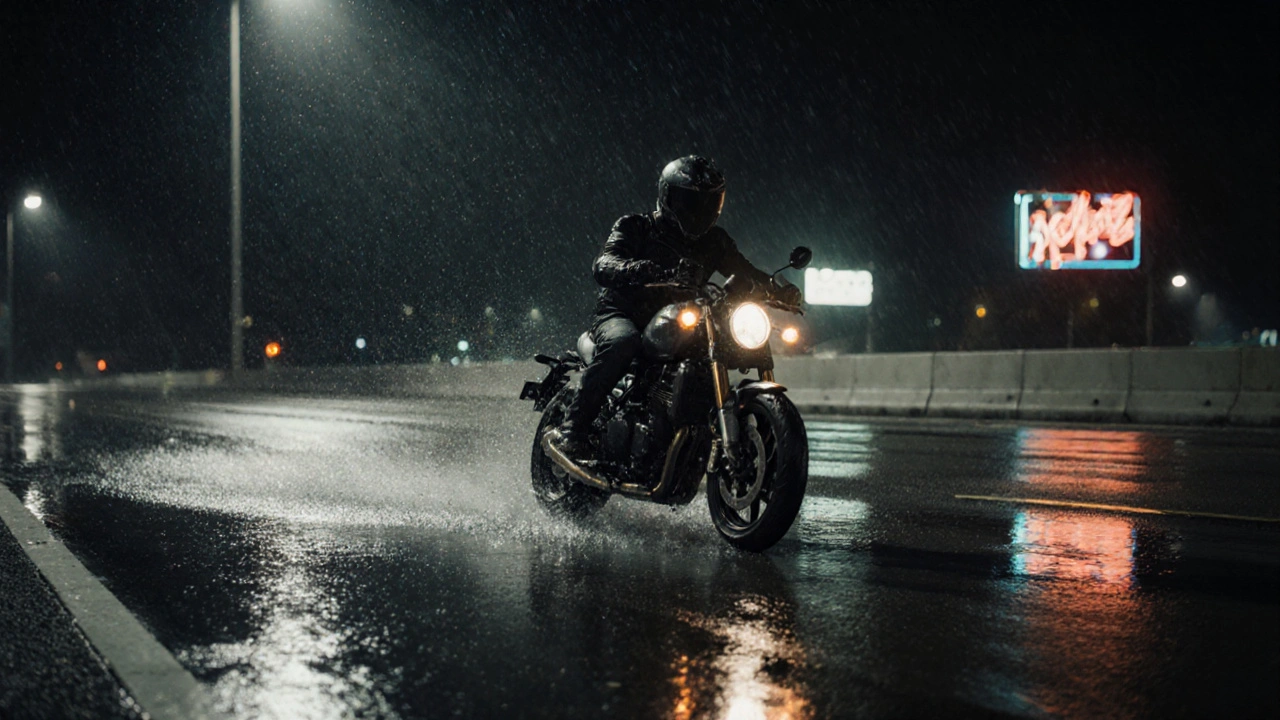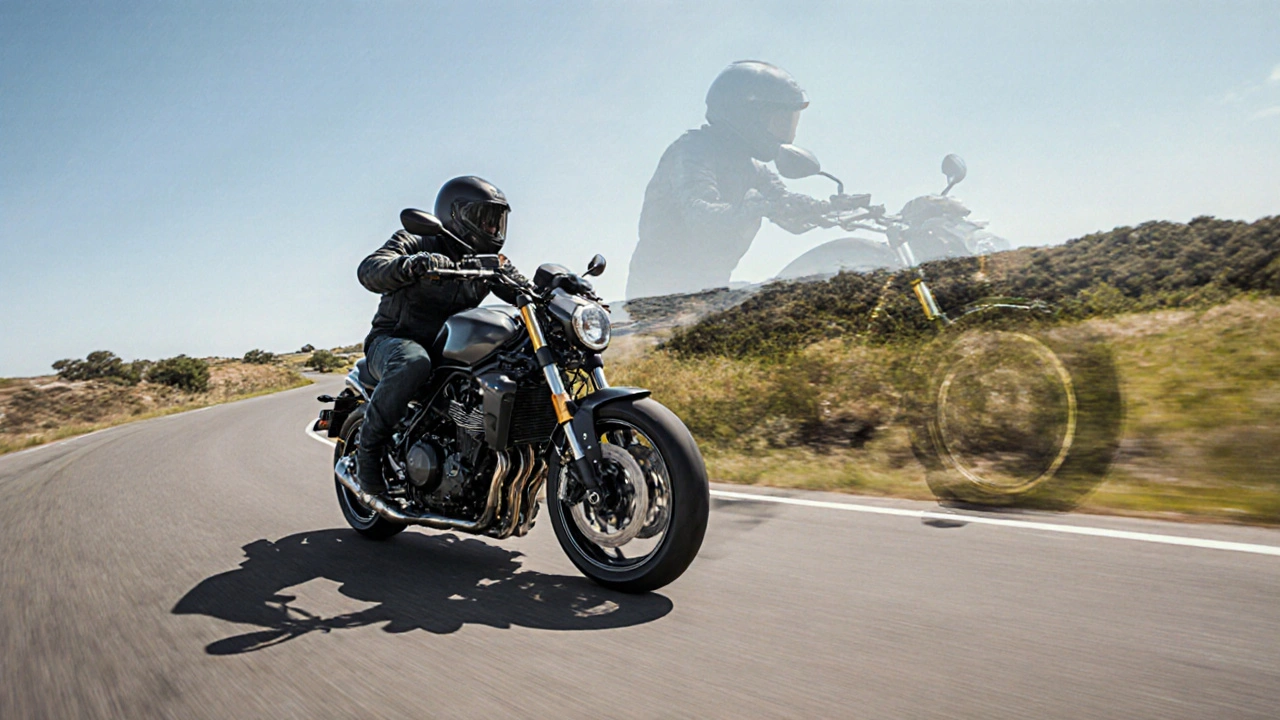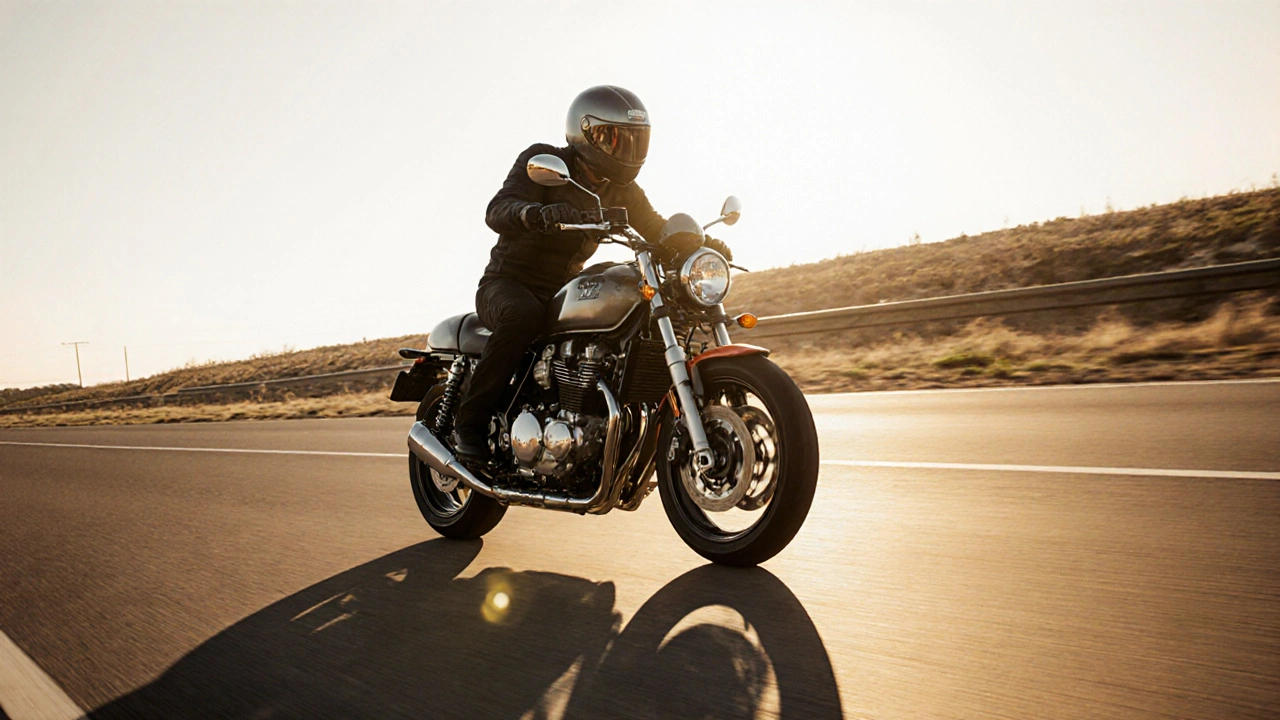When you’re riding at speed and suddenly need to stop-like a car pulling out ahead or a child chasing a ball into the road-your instinct might be to squeeze the brake lever hard. But squeezing too hard, too fast, can lock the front wheel and send you flying. That’s where advanced braking techniques like threshold braking and understanding ABS come in. These aren’t just for racers or track days. They’re survival skills for every rider who wants to stop faster and stay upright when it matters most.
What Is Threshold Braking?
Threshold braking is the art of braking right up to the point where the tire is about to lose grip, but not quite crossing it. It’s the sweet spot between maximum deceleration and maintaining control. On a motorcycle, the front brake provides about 70-80% of your stopping power. That means if you’re not using it properly, you’re wasting half your ability to stop.
Think of it like walking a tightrope. Too little pressure, and you take too long to stop. Too much, and you crash. The goal is to apply just enough force to make the front tire squeal slightly, feel the bike lean forward, and sense the tire hovering on the edge of grip. You don’t need to lock the wheel-you need to feel it almost lock.
Practicing threshold braking on a quiet, empty road or an empty parking lot is essential. Start at 30 mph, apply the front brake smoothly and progressively. Feel the weight transfer. Notice how the front forks compress. Gradually increase pressure until you feel the tire start to shudder-that’s your threshold. Then back off just a little. That’s your braking zone. Repeat this until your body remembers the feeling. You’re training your fingers, your core, your instincts.
How ABS Works on Motorcycles
ABS-Anti-lock Braking System-was once seen as a gadget for cruisers and touring bikes. Now, it’s standard on almost every new motorcycle sold in the EU and US. But many riders still don’t understand how it actually works, or worse, they think it’s a crutch.
ABS doesn’t stop you faster. It stops you more safely. When the system detects that a wheel is about to lock, it pulses the brake pressure dozens of times per second. This lets the tire keep rolling, maintaining steering control. On wet roads, gravel, or uneven surfaces, that’s a game-changer.
Here’s the truth most riders miss: ABS doesn’t replace threshold braking-it enhances it. On a dry road, a skilled rider can often stop just as fast without ABS. But on a slick surface, or when you panic and grab the brake, ABS kicks in and saves you from yourself. It’s not about letting the computer do the work. It’s about trusting the system so you can focus on where you’re going, not whether you’ll slide out.
Test it yourself. Find a safe, empty stretch of wet asphalt. Ride at 40 mph and apply the front brake hard. You’ll feel the ABS pulsing through the lever. That’s not a malfunction. That’s the system working. If you panic and let go, you lose control. Keep pressure on. Let the ABS do its job.
Why You Can’t Just Use the Rear Brake
Some riders, especially those who learned on older bikes or in off-road settings, rely heavily on the rear brake. That’s fine for low-speed maneuvers or loose terrain. But on the road, at speed, the rear brake alone won’t cut it.
The rear tire has far less weight on it when you brake hard. That’s physics. As the bike dives forward, the rear tire lifts slightly and loses traction. Applying heavy rear brake pressure under hard deceleration will either do nothing-or cause the rear wheel to skid, leading to a high-side crash.
Use the rear brake as a stabilizer. A light tap helps settle the bike, especially when cornering or braking in a straight line. But your primary stopping force must come from the front. The rear brake is your assistant, not your main tool.

Braking While Cornering: The Dangerous Myth
There’s a dangerous idea floating around: “You shouldn’t brake while turning.” That’s not true. You can brake while cornering-but only if you know how.
When you’re leaned over, the tire’s contact patch is already working hard to maintain grip. Adding braking force reduces the tire’s ability to turn. Too much brake, and you’ll low-side. But a gentle, progressive application of the front brake-especially in the first half of the turn-can actually help you tighten your line and exit faster.
This is called trail braking. It’s an advanced technique used by racers and experienced riders. The key is smoothness. You don’t yank the lever. You roll it on gradually as you enter the corner, then ease off as you stand the bike up. It takes practice, and it’s not for beginners. But understanding it helps you avoid panic braking mid-turn.
If you find yourself entering a corner too fast, the best move isn’t to brake harder. It’s to straighten the bike slightly, brake firmly in a straight line, then re-lean and continue. Your tires can’t do two things at once-turn and stop-without enough grip. Prioritize stopping before turning.
Real-World Scenarios: What Works and What Doesn’t
Let’s say you’re riding through a village at 40 mph. A parked car door swings open. You’ve got less than two seconds to react.
What do you do?
- Wrong: Slam the rear brake. Panic grab the front. Look down at the door.
- Right: Look where you want to go-past the door. Apply the front brake firmly but progressively. Let ABS do its job if your bike has it. Keep your body relaxed. Use your legs to stabilize the bike. Steer around the obstacle.
Another scenario: rain. You’re on a highway, and ahead, there’s a patch of oil slick. You see it too late. Do you lift off the brake? No. Keep pressure on. ABS will keep the tire rolling. Lifting off means you lose control. Trust the system.
On gravel? Same thing. Don’t panic. Keep the bike upright, apply steady front brake, and let the ABS modulate. The gravel will slow you down naturally. Fighting it makes things worse.

Training and Practice: Build Confidence, Not Just Skill
You can’t learn advanced braking from a video or a blog. You need to feel it. That’s why rider training courses exist. The Motorcycle Safety Foundation (MSF) and similar programs in the UK and EU offer advanced braking clinics. These aren’t just theory-they’re on-track sessions with cones, wet surfaces, and instructors watching your technique.
If you’ve never practiced threshold braking, start here: Find an empty parking lot. Mark a starting line. Ride up to 25 mph. Brake as hard as you can without locking the front. Note how far you stop. Do it again. Push a little harder each time. Track your stopping distance. After 10 tries, you’ll notice a difference.
Then try it with the rear brake only. You’ll see how much longer it takes. Then try both together. Feel how the rear stabilizes the front. Now try it on a wet patch of concrete. Feel the ABS kick in. That’s your new baseline.
Practice doesn’t make perfect. Perfect practice makes perfect. Slow, deliberate, focused sessions are worth more than hours of reckless riding.
Equipment Matters: Tires, Brake Pads, and Suspension
Even the best technique fails if your gear isn’t up to par. Your tires are the only part of your bike touching the road. Worn tires? No matter how good your braking is, you’re one bad patch away from disaster.
Check your tire tread depth. If it’s below 1mm, replace them. Use tires designed for road use-not off-road or touring tires if you ride hard. A good set of sport tires can cut your stopping distance by 15% compared to worn, cheap ones.
Brake pads matter too. Stock pads are fine for commuting. But if you ride aggressively, upgrade to sintered or semi-sintered pads. They handle heat better and give more consistent feel under hard use.
Suspension is often ignored. If your front forks are soft or worn, your bike will dive too much under braking. That reduces front tire contact and makes threshold braking harder. Get your suspension checked every 10,000 miles. Adjust preload if you carry a passenger or luggage.
Final Thought: Braking Is a Skill, Not a Panic Response
The best riders aren’t the ones who ride the fastest. They’re the ones who can stop the quickest-and stay in control. Advanced braking isn’t about showing off. It’s about survival. It’s about giving yourself room to react, to avoid the unexpected, to come home at the end of the day.
Every time you ride, ask yourself: How would I stop if something suddenly appeared? Then practice. Not just once. Not just once a year. Every few months. Because your reflexes fade. Your confidence grows only when you’ve tested it.
Threshold braking and ABS aren’t magic. They’re tools. And like any tool, they’re only as good as the person using them. Master them, and you don’t just ride safer-you ride with more confidence, more control, and more freedom.
Can I rely only on ABS to stop my motorcycle quickly?
No. ABS helps prevent wheel lock and keeps you in control, but it doesn’t shorten stopping distance on dry pavement compared to expert threshold braking. It’s a safety net, not a performance booster. You still need to apply firm, progressive brake pressure.
Is threshold braking safe on public roads?
Yes-if practiced correctly. Threshold braking is the most effective way to stop quickly on dry pavement. But it requires training. Don’t try it in traffic or on unfamiliar roads. Practice in empty lots first, then gradually apply it in real-world conditions with awareness of road surface and traffic.
Do I need to upgrade my brakes to use advanced techniques?
Not necessarily. Stock brakes are fine for learning. But to get the most out of advanced braking, ensure your tires are in good condition, brake pads aren’t worn, and suspension is properly set up. Upgrading to better pads or braided brake lines can improve feel and consistency, but technique matters more than hardware.
Why does my front brake feel spongy?
A spongy brake lever usually means air in the brake line or worn brake fluid. Brake fluid absorbs moisture over time, reducing its effectiveness. Flush and replace the fluid every two years. If the problem continues, bleed the brake system or have it checked by a mechanic.
Can ABS prevent all types of motorcycle crashes?
No. ABS only prevents wheel lock during braking. It won’t stop you from hitting something if you’re going too fast, misjudge a turn, or ride on extremely slippery surfaces like ice. It’s one tool in your safety toolkit-not a substitute for awareness, speed management, or good riding habits.


Comments
Jeremy Chick
Bro, I locked my front wheel on wet pavement last month and went airborne like a damn rocket. ABS saved my life. I used to think it was for wimps until I learned the hard way. Now I just squeeze and trust it. No more panic releases. Ride smart, not hard.
November 10, 2025 at 12:16
Christina Kooiman
Let me just say-this article is beautifully written, and I appreciate the care taken to explain threshold braking without drowning readers in technical jargon. But I must correct one thing: the phrase 'the rear brake is your assistant' is grammatically inaccurate. It should be 'the rear brake is your assistant *tool*'-or better yet, 'the rear brake serves as a stabilizing assistant.' Without the noun, the sentence collapses like a poorly tuned fork. Also, 'squeal slightly'-is that even a real mechanic term? Or just poetic license? I'm not here to nitpick, but clarity matters, especially when lives are on the line.
November 11, 2025 at 23:25
Stephanie Serblowski
ABS isn't a crutch-it's the bike's way of saying 'I got you, babe' 🤝✨. I used to think I was a badass until I tried threshold braking on a rainy highway. Spoiler: I wasn't. ABS kept me upright while I screamed internally. Now I ride like I'm dancing with gravity-and it feels like magic. Also, if you're still using stock pads on a 2020+ bike, you're basically driving a Ferrari with bicycle brakes. Upgrade. Please.
November 13, 2025 at 03:22
Renea Maxima
What if braking is just society's way of forcing us to confront our fear of momentum? We're taught to stop, to control, to obey the road-but what if the road doesn't want us to stop? What if the true freedom is in letting go? ABS is just a band-aid on the wound of modern anxiety. We don't need better brakes-we need better souls. 🌌
November 13, 2025 at 19:27
Seraphina Nero
This is such a needed post. I'm a new rider and I was terrified of the front brake. Reading this made me feel less alone. I practiced in an empty lot last weekend and actually didn't crash. Small win. Thank you for writing this like you actually care about people learning safely.
November 14, 2025 at 03:27
Megan Ellaby
Wait so if I'm going 50 and a dog runs out, I should brake HARD and not panic? Like... just keep pressure on? I thought you were supposed to let go? My dad always said 'let off if you feel it sliding'-but now I'm confused. Is he wrong? 😅
November 14, 2025 at 16:51
Rahul U.
Excellent breakdown. I ride in monsoon season in Kerala and ABS is my co-pilot. Tires matter more than you think-I swapped to Michelin Pilot Road 5s and stopped 3 meters shorter on wet asphalt. Also, brake fluid flush every 12 months. No exceptions. 🛑💧
November 15, 2025 at 05:47
E Jones
They don't want you to know this, but ABS was invented by the military to control soldiers' panic responses during combat. Now they're using it on your bike to make you docile. The government doesn't want you mastering threshold braking because if you could stop in 12 feet, you'd be too dangerous. They want you dependent. And those 'training courses'? Paid shills for Big Brake. I've been riding 30 years without ABS. I don't need a computer to tell me when to brake. My instincts are sharper than their algorithms. And if you think tires are that important-why do you think they're so expensive? Supply chain manipulation. Wake up.
November 15, 2025 at 16:30
Barbara & Greg
It is deeply concerning that the article casually encourages the use of threshold braking on public roads. One cannot ethically endorse such a high-risk maneuver without first mandating professional instruction, certification, and liability waivers. The casual tone implies that this is accessible to the average commuter, which is both irresponsible and potentially lethal. One does not simply 'practice in a parking lot' and then apply it to a school zone. The moral implications are staggering.
November 17, 2025 at 12:09
selma souza
This article is riddled with grammatical errors and misleading terminology. 'Squeal slightly'? No reputable mechanic uses that phrase. 'Threshold braking zone'? Redundant. 'Panic grab'? Unprofessional. The entire piece reads like a blog post written by someone who watched two YouTube videos. And the claim that ABS doesn't shorten stopping distance on dry pavement? That's flat-out false. Independent tests show it's within 2-3% of expert braking. You're misleading people. Shame.
November 17, 2025 at 22:54
Frank Piccolo
Look, I ride a Harley. I don't need no fancy tech. I just yank the lever and let the bike do what it's built for. ABS? That's for Europeans who can't handle real roads. And this 'trail braking' nonsense? Sounds like something a Japanese racer made up to sell more tires. I stop when I want to stop. Period. And if I crash? At least I died with my boots on.
November 18, 2025 at 15:38
Sagar Malik
Actually, you're all missing the deeper metaphysical layer here. Threshold braking isn't about physics-it's about *karma*. When you apply pressure to the brake, you're applying pressure to your ego. The moment you feel the tire shudder? That's your soul recognizing its own fragility. ABS? A digital manifestation of collective fear. And tires? They're not rubber-they're the skin of the machine, the interface between human will and cosmic chaos. If you don't feel this, you're not riding-you're just commuting. And your brake fluid? It's not fluid-it's liquid time. Flush it, and you flush your past. 🌀
November 20, 2025 at 14:34
Jeremy Chick
LOL @ the conspiracy guy. I'm not scared of the system-I'm scared of me not knowing how to use it. You think I'm gonna let a government algorithm save me? Nah. I just want to live long enough to ride again tomorrow. And yeah, I got my fluid flushed last month. No shame in being prepared.
November 21, 2025 at 09:11